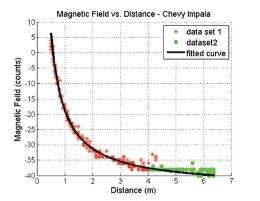October 18, 2011 feature
Magnetic sensors can measure distances between vehicles

(PhysOrg.com) -- Every vehicle has a magnetic field, and researchers have now found that a vehicle’s magnetic field has an inverse relationship with distance at small distances. The relationship provides a way to estimate a vehicle’s position using its magnetic field when the vehicle is less than a few meters away, which could be useful for detecting imminent collisions just before they occur.
S. Taghvaeeyan and R. Rajamani of the University of Minnesota have published their study on using vehicles’ magnetic signatures for position estimation in a recent issue of Applied Physics Letters.
“The main sources of magnetic fields are the magnetized steel belts in the tires, the ignition, the alternator, air conditioning system, speakers, etc.,” Rajamani told PhysOrg.com. “The significant metal in the engine block, transmission, driveline, etc., can also be magnetized.”
To measure a vehicle’s magnetic field, the researchers used anisotropic magnetoresistive (AMR) sensors on the vehicle that’s doing the measuring, while the other vehicles do not need to be equipped with any kind of device. The AMR sensors, which contain silicon chips with a thick coating of piezoresistive nickel-iron, can detect a change in the ambient magnetic field induced by a passing vehicle. The change in magnetic field causes a change in the resistance of the nickel-iron layer in the AMR sensors. While measuring a vehicle’s magnetism has previously been used to measure traffic flow rates on a road, it’s never been applied to estimating the distance between two vehicles.
In their study, the researchers performed a theoretical analysis and experimental measurements with different vehicle types to determine exactly how the magnetism relates to distance. They found a clear non-linear relationship between the measured magnetic field and distance below about 6 meters.
“In general, the magnetic field for a magnetized body varies with the powers of the inverse of the distance,” Rajamani said. “In the case of cars, we were able to show in this paper that cars have a magnetic field and that the variation could be described by a first order inverse relationship with distance.”
However, the researchers also found that this relationship depends on the type and size of a vehicle, and also changes from one location to another. To estimate a vehicle’s position without knowing these variables, the researchers found they could use two AMR sensors separated by a certain distance along with an adaptive estimation algorithm. As long as an approaching vehicle is close enough to affect both AMR sensors, the two sensors can accurately estimate its position, regardless of the vehicle type, vehicle size, or general location.
The magnetic field technique is not the first attempt at measuring inter-vehicle distances. Currently, some luxury vehicles use radar or laser sensors to measure distances to other vehicles. However, these sensors have two drawbacks: they cannot measure distances of less than 1 meter, and a typical radar distance measuring unit can cost over $1000. In comparison, the AMR sensors can measure distances of less than a meter and cost less than $10.
By further improving these sensors and tailoring them for commercial use, the researchers envision that the sensors could be applied all around a vehicle’s body, where they could detect nearby vehicles in all directions.
“The sensors will be useful for detecting an imminent collision,” Rajamani said. “The sensors will provide information on the relative velocity and position of the impending crash on the vehicle. This could be used to pre-tighten seat belts, inflate airbags and deploy other active structural enhancement measures that can protect the occupants in the car during the crash.”
More information: S. Taghvaeeyan and R. Rajamani. “Use of vehicle magnetic signatures for position estimation.” Applied Physics Letters 99, 134101 (2011). DOI:10.1063/1.3639274
Copyright 2011 PhysOrg.com.
All rights reserved. This material may not be published, broadcast, rewritten or redistributed in whole or part without the express written permission of PhysOrg.com.



















